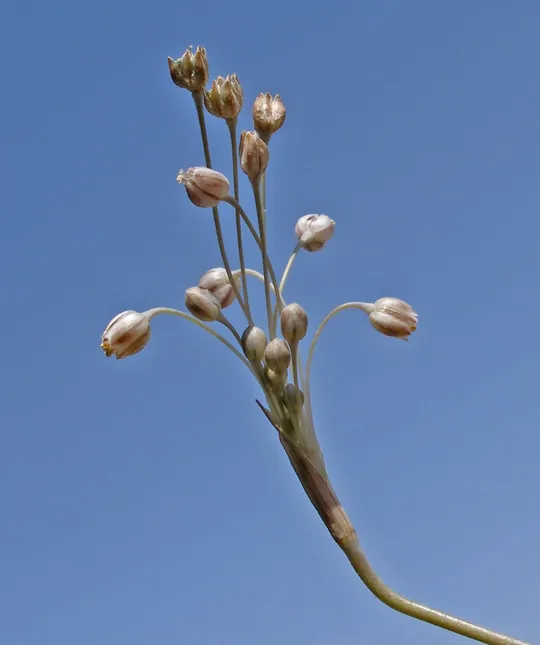Kollmann's Garlic
Allium kollmannianum


Allium kollmannianum has been found so
far only on two sites in the northern Negev: north of Be'er Sheva and near
Dimona. Since the plant blooms in the dry, hot season in the Negev, when few
surveys and trips are held, it is estimated that the plant is found on about
ten sites.
Loess and sandy
flats in the desert, in areas where the annual average annual precipitation is
100-200 mm, dominated by Anabasis articulata and other dwarf shrubs.
For the genus –
see Allium tardiflorum, A. papillare.
A. kollmannianum
was identified as a new species only in 1991; its bulbs and those of other Allium
species were collected in Israel in spring 1989 by an OPTIMA (Organization for
the Phyto-Taxonomic Investigation of the Mediterranean Area) expedition. The bulbs were grown in the Botanical Garden in Catania
(Sicily) and used for karyology research (the number and structure of
chromosomes). Among the plants that budded and bloomed were Allium
plants unknown to the researchers and they (see above) described them in 1991
as a new species to science, which they named after the late Dr. Fania
Kollmann, an international Allium expert from the Hebrew University, who
contributed to knowledge of the Allium species in Israel and throughout
the Mediterranean region. The plants were collected from three sites (Brullo et
al., 1991). A. kollmannianum
is unique in its morphology and karyology and is very different than other Allium
species, and therefore it was described as a new species. This species shows some
similarity to the A. cupanii
species group from the section Brevispatha, which is characterized by
reticulate bulb coats and hairy leaves (Brullo et al., 1991). According to
these investigators, despite the differences between A. kollmannianum
and A. cupanii and its close species, it can still
be ascribed to the section Brevispatha. For 16 years A.
kollmannianum was not
known to Israeli botanists in the field and it was even suggested that the
bulbs that grew in Italy were deformed plants that did not grow under desert
conditions and were not really a new species. At the end of May 2007 Oz Golan
found an unidentified Allium north of Be'er Sheva, and its shape and its
late flowering season once again raised the possibility that it was a new species,
but following a literature survey it was immediately found to be precisely the
plant that had been described as A. kollmannianum from the bulbs collected in the
Negev in 1989, and that it is indeed different from the other species of Allium
in Israel.
·
The two Allium kollmannianum sites were discovered
in the Negev only in the past two decades, and it is unclear whether these are
all the sites in Israel. There is also no available information on its long
term change trend.
·
Thousands of plants were observed at the Be'er Sheva site
in the year A. kollmannianum was discovered (2007).
·
The expansion of construction and development from Be'er
Sheva to the north may lead to habitat loss and extinction of the population.
·
A. kollmannianum
is not protected in a nature reserve.
·
It is endemic to Israel and its local threat level is equivalent
to its global threat.
Thorough field
surveys should be carried out during the month of May in the loess regions
north of Be'er Sheva and eastwards towards Arad and Dimona in the northern
Negev, to locate additional Allium kollmannianum populations and update the status of this unique species in Israel.
Samples of this rare and endemic Allium species should be collected from
the area north of Be'er Sheva and grown in refuge gardens, before construction
and development spread further.
Allium kollmannianum is endemic to
the northern Negev in Israel.
Allium kollmannianum is a geophyte that grows in the northern Negev on loess soils. It was found in Israel for the first time in 1989, described as new species to science in 1991 and its existence in Israel was reconfirmed in 2007. A. kollmannianum is endemic to Israel and the site with the largest population is threatened by development.
Brullo, S., P. Pavone and C. Salmeri, 1991. Allium kolmannianum, a new species from Israel. Flora Mediterranea 1:
15-20.
Current Occupancy Map
| 1000 squre meter pixel | 5000 squre meter pixel | 10000 squre meter pixel | |
|---|---|---|---|
| number of observations | 0 | 0 | 0 |
| in total pixels | 0 | 0 | 0 |
| Family | Liliaceae |
| Classification | Unlisted |
| Ecosystem | Desert |
| Chorotype | Saharo – Arab Irano - Turanian |
| Conservation Site | Goral Hills north of Be'er sheva |
| Rarity |
1
1
6
|
|---|---|
| Vulnerability |
0
1
4
|
| Attractiveness |
0
0
4
|
| Endemism |
0
4
4
|
| Red number |
1
3.2
10
|
| Peripherality | 0 |
| IUCN category | DD EW EX LC CR EN VU NT |
| Threat Definition according to the red book | Critically endangered |
 Based on:
Based on:






